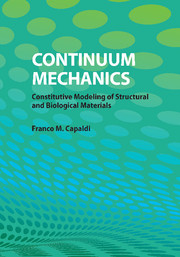2 - Kinematics
Published online by Cambridge University Press: 05 August 2012
Summary
Kinematics is the study of motion without regards to the forces responsible for that motion. Intuitively, we know that the application of a force can lead to the movement of an object. The equations characterizing this movement are called the equations of motion. Perhaps, we might compute the displacement of an object by measuring how far it has moved from its initial location. In this chapter, we will build on these intuitive concepts to explore the kinematics of deformable continua. We will show how simple geometric relations allow us to compute the deformation and strain from the equations of motion. Similarly, the velocity and acceleration fields may be determined by differentiation the equations of motion.
Configurations
We know that matter consists of atoms, which consist of protons, electrons, and neutrons, all of which consist of quarks. However, this level of detail can often be ignored when mathematically modeling a macroscopic object's response to external fields. The true discreet nature of material can be modeled as a continuous distribution of mass and the atomic or subatomic structure can be ignored. Within this representation, an object is no longer made up of a finite set of atoms each with its own mass or charge but instead consists of an infinite number of material points or particles. Instead of defining atomic mass or charge, we define a density and a charge density field.
- Type
- Chapter
- Information
- Continuum MechanicsConstitutive Modeling of Structural and Biological Materials, pp. 35 - 73Publisher: Cambridge University PressPrint publication year: 2012



